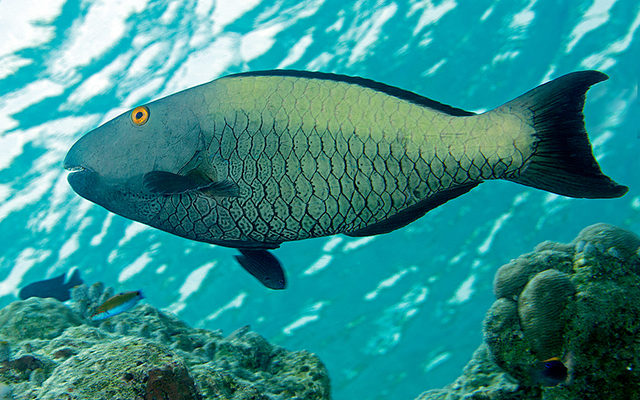| Scaridae (Parrotfishes), subfamily: Scarinae |
| 80 cm SL (male/unsexed) |
|
reef-associated; marine; depth range 0 - 30 m |
| Indo-Pacific: from Somalia to South Africa, eastwards to the Tuamotos including eastern Australia and Middleton Reef; north to southern Japan; south to western Australia. |
|
This species is characterized by the following: 14-15 (usually 14) pectoral rays; 5-7 (usually 6) median predorsal scales; 3 rows of scales on cheek, the lower one with 3-7 scales; nodular outer surface of dental plates (vs. smooth on Chlorurus, Hipposcarus and Scarus); conical teeth absent on side of dental plates; lips largely covering dental plates; long snout 1.8-2.2 in HL; juveniles with rounded caudal fin, emarginate in adults. Initial phase with head purplish to reddish brown, finely spotted with black ventrally; body with a broad, pale yellowish zone dorsally, bluish gray below; scales rimmed and spotted with black; median fins brownish red and caudal with a whitish crescent posteriorly. Terminal males green, scales rimmed with pink, head and anterior body with numerous small pink spots except below an orange line from corner of the mouth to pectoral base and across upper abdomen, where solid green with broad, pink, longitudinal ventral band; juveniles white with a broad, dark-edged orange bar covering head except snout and chin, a large, orange-rimmed black spot anteriorly in dorsal fin, and a broad, submarginal orange band in caudal fin (Ref. 54980). |
| Inhabits seaward reefs and clear lagoons (Ref. 1602), at depths of 1-30 m. Occurs in groups of females with one male (Ref. 90102) form harems; while juveniles are usually solitary (Ref. 9710). Males are territorial. Goes to several changes during growth and very large females change sex to the brightly colored male. Small juveniles usually in dense coral and algae habitats (Ref. 48636). Feeds on benthic algae (Ref. 89972). Minimum depth reported taken from Ref. 128797. |
|
Least Concern (LC); Date assessed: 17 September 2009 Ref. (130435)
|
| harmless |
Source and more info: www.fishbase.org. For personal, classroom, and other internal use only. Not for publication.

